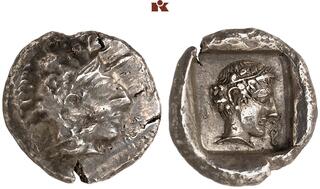| Fritz Rudolf Künker GmbH & Co. KG > Auction 402 | Auction date: 14 March 2024 |
| Lot number: 122 Price realized: 800 EUR (Approx. 871 USD) Note: Prices do not include buyer's fees. | Show similar lots on CoinArchives Find similar lots in upcoming auctions on |
| Lot description: LYCIA. Dynastische Prägungen. Wekhssere I AR-Tetrobol, 440/430 v. Chr., Xanthos; 2,88 g. Athenakopf r. mit attischem Helm//In Incusum: Apollokopf r. mit Lorbeerkranz, r. Diskelis. Müseler V, 10 (dies Exemplar, dort mit irrtümlicher Datierung); Müseler in Gephyra 17 (2019), I.1.9.b (dies Exemplar). R Feine Tönung, sehr schön/vorzüglich Exemplar der Auktion Peus Nachf. 328, Frankfurt am Main 1990, Nr. 231 und der Auktion Münzen und Medaillen Deutschland GmbH 4, Stuttgart 1999, Nr. 153. Das häufige Vorkommen der Athena auf lykischen Münzen hat gewiss mit dem Ausgreifen des athenischen Seebundes zu tun. Durch den athenischen Imperialismus wurden die athenischen Tetradrachmen mit dem Bild der Athena zu einem der geläufigsten Zahlungsmittel. Die athenische Expansion ist aber sicherlich nicht die Ursache für die Beliebtheit von Athenadarstellungen; eher dürfte das Gegenteil der Fall sein. Das geht allein schon daraus hervor, dass die Lykier unter Kheriga sich wieder enger an die Perser anlehnten, dennoch weiterhin oder sogar verstärkt Münzen mit Darstellungen der Athena prägten. Wir sollten stärker in Betracht ziehen, dass hinter Athena die kleinasiatische kriegerische Göttin Malija steht (vgl. Barnett 1974). Insofern handelt es sich eher um Darstellungen der Malija in griechischer Ikonographie als um die griechische Göttin. Das schließt nicht aus, dass sich lykische Konzeptionen von Malija mit griechischen von Athena vermischten. Bezeichnend ist, dass in dem griechischen Gedicht auf dem Inschriftenpfeiler von Xanthos die dort genannte Athena das Epithet ,ptolioporthos', d.h. ,städtezerstörend' trägt (vgl. dazu Raimond 2007, 156). Sie ist eine Helferin und Schützerin der Dynasten, insbesondere auf ihren stetigen Feldzügen, so dass Christian Le Roy beizupflichten ist: "Die Rolle der Göttin Malija, die von den Griechen mit Athena gleichgesetzt wurde, ist eindeutig. Sie war Beschützerin der Dynasten, noch bevor sie Schutzherrin der Städte wurde" (Le Roy 1990, 42). Xanthos und Patara könnten Zentrum ihres Kults gewesen sein (Keen 1998, 203). Malijas Bedeutung scheint zugenommen zu haben, als im letzten Viertel des 5. Jhdts. die Kämpfe und Hegemonialbestrebungen der Dynasten zunahmen. [JN] The frequent occurrence of Athena on Lycian coins certainly has to do with the expansion of the Athenian naval league. As a result of Athenian imperialism, Athenian tetradrachms with the image of Athena became widespread and also one of the most common means of payment in the East. However, Athenian expansion is certainly not the cause of the popularity of Athena images on Lycian coins. This can be seen from the fact that the Lycians under Kheriga again aligned themselves more closely with the Persians, but nevertheless continued or even increased to mint coins with depictions of Athena (cf. Keen 1998, 202). We should take greater account of the fact that Lycian 'Athena' is associated with the Asia Minor warrior goddess Malija (cf. Barnett 1974). In this respect, we are dealing more with depictions of Malija in Greek iconography than with the Greek goddess Athena. This does not exclude the possibility that Lycian conceptions of Malija were mixed with Greek ideas about Athena. It is significant that in the Greek poem on the Inscription Pillar of Xanthos, the Athena mentioned there bears the epithet 'ptolioporthos', i.e. 'destroying cities' (cf. Raimond 2007, 156). She is the dynasts' helper and protectress, especially during their constant armed campaigns, as Christian Le Roy states (transl. by J. Nollé): "The role of the goddess Malija, who was equated with Athena by the Greeks, is clear. She was the protector of the dynasts even before she became the patroness of the cities" (Le Roy 1990, 42). Xanthos and Patara could have been centres of her cult (Keen 1998, 203). Malija's importance seems to have increased in the last quarter of the 5th century when the struggles and hegemonic endeavours of the dynasts intensified. [JN] Estimate: 500 EUR |  |



